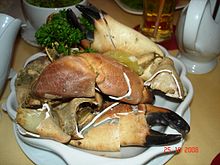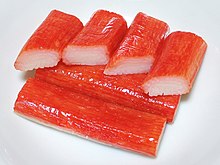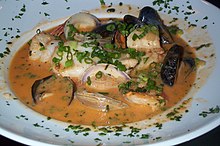Crustaceans
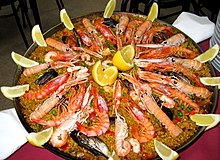
In the kitchen language, crustaceans are crustaceans (crustacea) used as food . In culinary arts , the term crustaceans has prevailed over the term crustaceans. In cookbooks, they are often assigned to the shellfish and crustaceans category together with shellfish (sometimes also crustaceans and shellfish ). In the English-speaking world, the term shellfish encompasses shellfish and crustaceans as well as echinoderms and molluscs living in water ; there is some overlap with seafood .
The best-selling crustaceans in Europe are shrimp . With a few exceptions, all crustaceans belong to the order of the decapods ("decapods"; Decapoda). The crustaceans have their range and their habitat like the fish in salt water as well as in fresh water . In addition to the shrimp species of lobster-like , crayfish , lobsters , and live in freshwater crayfish and parastacidae used as food. Crabs , such as the edible crab , are much less common . Crustaceans that do not belong to the decapod crabs are only eaten in small quantities, such as krill or mantis shrimp .
Variety of terms
shrimp
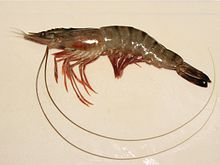
Shrimp are sold under various names, mostly under the English terms “prawn” or “shrimp”. Whereby the distinction is not clearly defined and relates to the size of the animals, "prawns" are generally larger. Particularly large specimens are also offered as “King” or “Jumbo prawn”. In the US, the term "shrimp" is much more common than "prawn", while the opposite is the case in the Commonwealth of Nations. In Spain prawns are called Gambas , in Italian Gamberone (large) or Gamberetti (small) depending on their size. "Scampi" is actually the Italian name for Norway lobster , and is also used for shrimp in German-speaking countries.
The term “Pacific shrimp” refers to different Penaeus species, some of which are also native to the Indian Ocean , such as “Black Tiger prawns” ( Penaeus monodon ). "Arctic sea shrimp" or "Arctic sea shrimp" and "Greenland crab" from the North Atlantic and North Pacific mainly belong to the species Pandalus borealis . The large "party prawns" and "king prawns" are mostly of the species Litopenaeus vannamei and come mainly from Indonesian or Thai breeding.
The term “North Sea Crab ” found in the trade is zoologically incorrect, as it is not a crab but a shrimp, the North Sea shrimp . Further names for the North Sea shrimp are “beach shrimp”, “garnet”, “shrimp” (from French “crevette” - there also generally for shrimp), “leek”, “knat” or “gray crab”.
Lobstery
Of the lobster-like especially to European and American lobster , the lobster and the Japanese Hummer used as food. You have pronounced scissors; their front body is much more developed compared to the shrimp. In French the Norway lobster is called “langoustine”, which brings it linguistically close to the much more expensive lobster . In the German-speaking world, the tails of the Norway lobster are often offered as "lobster tails" for the same reason. Equally misleading is the term "emperor lobster" for the Norway lobster. "Lobster crabs" are deep-sea shrimp .
Food allergies to crustaceans
Very many people have a food allergy to crustaceans (crustacean allergy ). It is more common in adults than children because children eat crustaceans less often. Children are more likely to have an allergy to fish. In the United States, allergies to shellfish are the most common type of allergy among adults. This allergy usually only manifests itself in adulthood. This allergy affects more women than men among adults. Boys are more likely to suffer from this form of allergy among children.
Shellfish is one of the eight most common food allergens in the United States. According to a survey, 2% of the US population are allergic to shellfish (2.3% to seafood). That is twice as many as are allergic to peanuts . The existence of any kind of allergy in the family is a risk factor for developing a crustacean allergy.
Compared to other food allergies, allergies to shellfish and crustaceans are the most common cause of allergic shock ( anaphylaxis ).
Although shellfish (mussels, oysters, etc.) and crustaceans are relatively far apart in their biological relationship, there are very often cross-allergies between crustacean allergies and shellfish allergies , as they contain similar proteins. The muscle protein tropomyosin is the triggering allergen. Tropomyosin is an important muscle structure protein in arthropods .
Shrimp (shrimp allergy) have the greatest allergy-causing potential, but lobsters (lobster allergy), lobsters (lobster allergies), crabs and mussels are also strong allergy triggers. The allergy does not have to be limited to one species, but can spread to other crustaceans, as there are cross-reacting allergens within the crustaceans. The above-mentioned cross allergies between shellfish and crustaceans also occur; also cross allergies to fish (fish allergy); Cockroaches and especially mites ( house dust allergy ) are not uncommon.
These allergic reactions set in immediately after consumption and are mainly mediated by immunoglobulin E (IgE). The severity of the allergic reactions can vary. In mild forms, hives (urticaria), nasal congestion, gastrointestinal symptoms, respiratory symptoms and / or circulatory reactions can be observed, in severe forms life-threatening allergic symptoms ( anaphylaxis ) occur.
An effective treatment for this allergy is not possible. Because of the frequent occurrence of cross-allergies, the consumption of both shellfish and crustaceans should be avoided. In the EU there is therefore an obligation to label allergens , which includes not only fish but also shellfish and crustaceans: According to directive "RL 2003/89 / EC" ("Annex III a of Directive 2000/13 / EC"), allergens are subject to declaration . Molluscs and mollusc products such as B. snails, mussels or oysters were later included in the directive "RL 2006/142 / EG". The last change to "Annex III a of Directive 2000/13 / EC" is in the form of Directive "RL 2007/68 / EC". However, this directive only applies to the labeling of packaged food, not to unpackaged food.
In the USA, cloves and crustaceans (shellfish) are also subject to labeling as allergens. The "Food Allergen Labeling and Consumer Protection Act" (FALCPA) regulates that crustaceans, but not molluscs, must be clearly identified on labels in the list of ingredients.
Shellfish and crustaceans are usually not hidden ingredients in food. However, problems can arise when eating in restaurants. Shellfish and crustaceans are particularly widespread in East Asian cuisine (Chinese, Thai, Japanese or Vietnamese food). In such restaurants there is also the risk of cross-contamination (e.g. grilling meat and crustaceans on the same grill) or simple confusion or incorrect information from the service staff due to ignorance. The problem is that even the smallest amounts of crustaceans can trigger the most severe reactions in people with a corresponding allergy. Some people are already allergic just touching crustaceans or inhaling steam from crustaceans that are cooking.
People at high risk who have already shown severe allergic reactions are advised to have an appropriate allergy passport and adrenaline with them for emergency treatment.
Surimi
Also surimi , a faux crab meat often contains extracts of shellfish to color it decoratively; these are noted on the label. In this case, it is unsuitable for allergy sufferers.
Glucosamine
A problem can arise when taking glucosamine . Glucosamine is taken in combination with chondroitin for the relief of osteoarthritis. Since glucosamine is often obtained from the chitinous exoskeleton of crustaceans, an allergic reaction is possible in sensitized people. However, since the allergy-triggering proteins are not found in the exoskeleton, the intake of glucosamine also appears to be harmless for allergy sufferers.
See also
literature
- Thomas Ruhl : The Sea: The Mollusc and Crustacean Culinarium. Umschau Buchverlag; 2007; ISBN 9783865282811
- Lothar Jäger (editor), Brunello Wüthrich (editor), Barbara Ballmer-Weber (editor), Stefan Vieths: Food allergies and intolerances: immunology - diagnostics - therapy - prophylaxis. Urban & Fischer Verlag 2008; ISBN 9783437213625
Web links
Individual evidence
- ^ Scott H. Safe, Anne Muñoz-Furlong, Hugh A. Sampson: Prevalence of seafood allergy in the United States determined by a random telephone survey. in Journal of Allergy and Clinical Immunology (JACI); Volume 114, Issue 1, July 2004, Pages 159-165; abstract
- ↑ Official Journal of the European Union (PDF)
